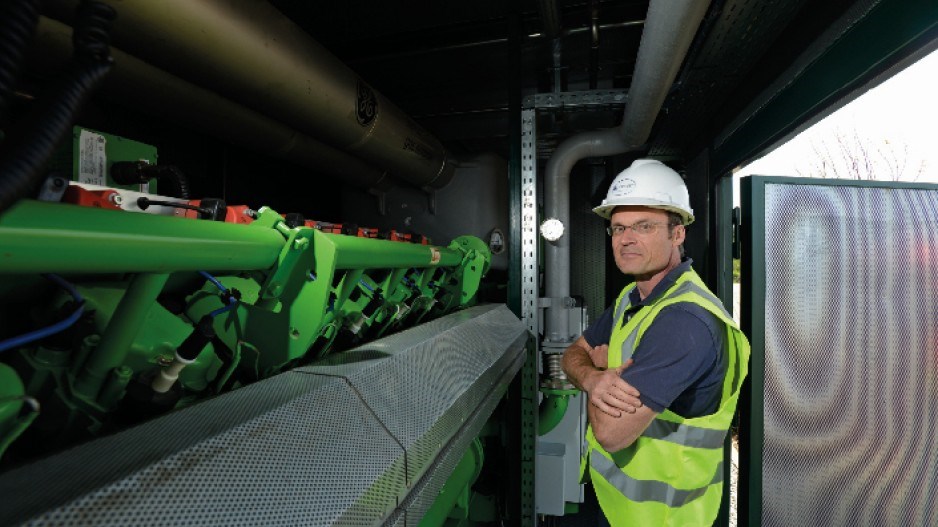Burning gas to create heat or electricity might sound like a strange way to address climate change. But when it’s biogas processed from landfills, sewage treatment plants and farms, there’s a twofold environmental benefit.
For one, it reduces the amount of non-renewable fossil fuels that would otherwise be burned with a renewable fuel.
Moreover, the methane created by landfills, farms and sewage treatment plants is at least 20 times worse than carbon dioxide because it traps more heat in the atmosphere.
Capturing it and turning it into biogas therefore reduces the amount of methane that would otherwise either escape into the atmosphere or – in the case of landfills – have to be flared, which is a waste of energy.
Currently, biogas accounts for just 0.07% of the gas burned in B.C., according to FortisBC. A push by the B.C. government to tap the renewable energy source of landfills is expected to push that to 2.6% by 2016.
“Methane is 26 times worse than CO2,” said Michael Weedon, executive director of the BC Bioenergy Network. “That’s why B.C. put in regulations that say you have to destroy this – you can’t just let it go into the atmosphere.
“Why continue to pollute [and] waste that resource? If you utilize that resource to make energy, then we will displace fossil fuel, which is another source of pollution. So you’ve got a double win here.”
The B.C. government has mandated that all landfills in B.C. generating 1,000 tonnes or more of methane annually need to install some kind of biogas system by 2016. To help foster innovation and fund the capital investments needed, the BC Bioenergy Network was set up with $25 million in funding.
To date, it has invested $16.9 million in 19 projects, which has helped leverage $123.5 million from the private sector and other levels of government.
Most of the projects are related to biogas generation, although some are focused on creating biocoal from wood or agricultural waste. One of the biggest and newest projects is the $20 million Harvest Power Energy Garden organics composting and biogas plant in Richmond.
Several Lower Mainland cities now have a curbside collection program for compostable kitchen waste. Most of the food waste and lawn trimmings go to Harvest Power’s plant, which creates fertilizer and biogas. The biogas is burned in generators to produce electricity, which is sold to BC Hydro.
The plant, which started selling electricity last month, can produce up to 8,000 megawatt-hours of electricity per year – enough to power 700 homes. The BC Bioenergy Network provided a $500,000 grant and $1 million loan for the project.
Less than half the organic waste in Metro Vancouver is being diverted for composting, said Harvest Power plant manager Dieter Geesing, who estimates there is enough organic waste in the region to power another two or three plants like the one in Richmond.
Economics and technology are no longer major barriers – the big hurdles now are land costs and NIMBYism.
“Most people support the idea, and they’re behind this,” Geesing said, “but few people would actually like a facility like this in their neighbourhood.”
Another innovation being funded by the BC Bioenergy Network is a $7.6 million demonstration project being developed by Quadrogen Power Systems Inc. in Delta.
One of the contaminants in landfill gas is siloxanes, which gum up internal combustion engines.
The Quadrogen process removes them to produce a cleaner biogas to produce electricity and has the added benefit of producing very pure CO2, which can be used by a greenhouse.
The project has received $2.6 million from Sustainable Development Technology Canada (SDTC), $1 million from the provincial government’s Innovative Clean Energy (ICE) fund, and will receive up to $1.5 million from the BC Bioenergy Network. •
Sewage treatment’s biogas potential
Landfills aren’t the only source of methane. Sewage treatment plants produce it too. Metro Vancouver has been developing initiatives recently to produce biogas at its Annacis Island and Lulu Island sewage treatment plants.
In 2011, the Annacis Island sewage treatment plant was outfitted with a $2.6 million digester to produce biogas from sludge.
“[Biogases] are going to be produced regardless, so let’s take advantage of that and let’s actually minimize the carbon impact,” said North Vancouver City mayor Darrell Mussatto, who chairs Metro Vancouver’s utilities committee.
The gas is burned in generators to produce electricity to offset the plant’s own energy consumption. Recently, Metro Vancouver added fats, oils and grease collected from restaurants to augment the feedstock at the Annacis Island plant.
“We decided that if we imported [fat, oils and grease], we could increase production of biogas by 10%,” Mussatto said.
Agriculture industry’s biogas potential
Agriculture is a major methane emitter. Farms therefore have huge biogas generation potential. The potential energy from organic material in the Fraser Valley alone is estimated to be 30 megawatts – enough to power 30,000 homes.
Two biogas projects are operating in Abbotsford. Bakerview EcoDairy uses an anaerobic digester to turn manure from its dairy operation into gas, which is burned to offset the farm’s natural gas and electricity needs. Fraser Valley Biogas produces gas from farm manure and food waste and sells it to FortisBC.
FortisBC also gets biogas from the Salmon Arm landfill, which has the capacity to produce 25,000 gigajoules of energy annually – enough to heat 300 homes.
FortisBC buys the gas at a premium, then recovers the added cost by collecting a voluntary premium from customers. Residential and business customers now have the option of buying “renewable” natural gas for about $5 per month above what they would normally pay. To date, 5,000 customers have subscribed to the renewable gas option.




